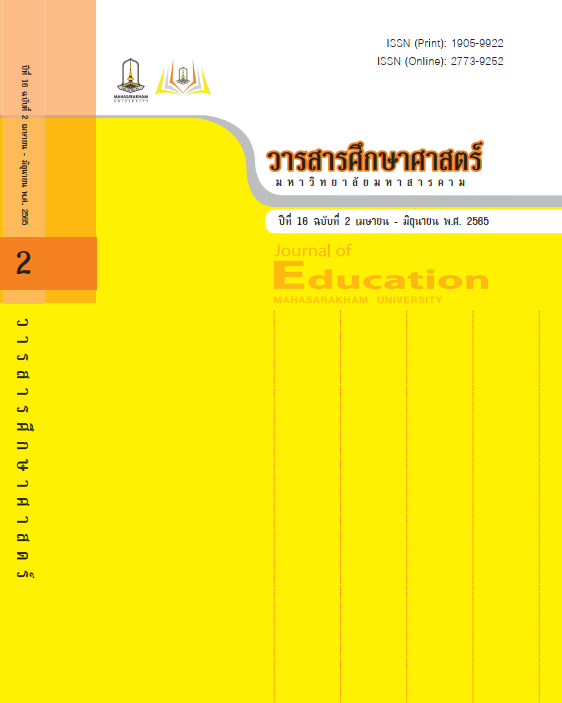The Development of An Integrated Learning Management Modelby Situational-based with Collaborative Learning Aimed at Improving Students’ Academic Achievement and Enhancing their Competencies in The Chemistry Curriculum on the topic of Chemistry Bonding of Math
Main Article Content
Abstract
The objectives of this research were to 1) develop an integrated learning management model. and 2) to study the results of the learning management model experiment as follows: 2.1) to compare the learning achievements in chemistry courses before and after school; 2.2) to study the results of promoting core competencies. After learning chemistry course and 2.3) to study the level of satisfaction towards the learning management model. The population used in the research were 9 chemistry teachers and 647 Mathayomsuksa 4 students in the first semester of the academic year 2021. The experimental group used in the research consisted of 1 Mathayomsuksa 4 students in 1 room 30. Cluster random sampling. Research tools consisted of 1) a learning management plan, 2) an achievement test before and after school, 3) an assessment of core competency promotion before and after school, and 4) a questionnaire on the level of satisfaction towards learning management model The statistics used in the data analysis were percentage, mean, standard deviation. and hypothesis testing using t-test (Dependent Samples).
The results of the research showed that 1) the model of learning management There are 7 components of the learning management model: (1) the model’s principle, (2) the model’s objectives, (3) concepts and theories in model development, (4) the learning management process consists of 6 steps: 1 presenting the problem situation, step 2 planning, step 3 problem solving, step 4 reflecting, step 5 conceptualization, and step 6 evaluation (5) measurement and evaluation (6) teacher and student roles, and (7) Support system 2) The experimental results using the learning management model found that (1) the students in the experimental group had a statistically significantly higher score on learning achievement after school than before at the.05 level; (2) the students The experimental group had a 45.53% increase in the developmental scores of the two core competencies, and (3) The students’ satisfaction with the learning management style had an average of 4.31, meaning that the students in the experimental group had a high level of satisfaction.
Downloads
Article Details

This work is licensed under a Creative Commons Attribution-NonCommercial-NoDerivatives 4.0 International License.
References
กระทรวงศึกษาธิการ. (2560). มาตรฐานการเรียนรู้และตัวชี้วัด กลุ่มสาระการเรียนรู้คณิตศาสตร์ วิทยาศาสตร์ ในกลุ่มสาระการเรียนรู้สังคมศึกษา ศาสนา และวัฒนธรรม (ฉบับปรับปรุง 2560) ตามหลักสูตรแกนกลางการศึกษาขั้นพื้นฐาน พุทธศักราช 2551. กรุงเทพมหานคร: โรงพิมพ์ชุมนุมสหกรณ์การเกษตรแห่งประเทศไทย จำกัด.
ขวัญชัย ขัวนาและคณะ. (2561). การพัฒนารูปแบบการเรียนการสอนเพื่อส่งเสริมทักษะการเรียนรู้ในศตวรรษที่ 21. วารสารมนุษยศาสตร์และสังคมศาสตร์ มหาวิทยาลัยมหาสารคาม, 37(2). 77-96
เขมณัฏฐ์ มิ่งศิริธรรม. (2559). การออกแบบสื่อการศึกษาสร้างสรรค์ = (Creative educational media desing). กรุงเทพมหานคร: สำานักพิมพ์แห่งจุฬาลงกรณ์มหาวิทยาลัย.
ทรงศักดิ์ ภูสีอ่อน. (2563). การวิจัยและพัฒนาทางการศึกษา (พิมพ์ครั้งที่ 2). มหาสารคาม: ตักสิลา การพิมพ์.
บุญชม ศรีสะอาด. (2545). การวิจัยเบื้องต้น (พิมพ์ครั้งที่ 7). กรุงเทพมหานคร:สุวีริยาสาส์น.
ประสาท เนืองเฉลิม. (2560). วิจัยการเรียนการสอน (พิมพ์ครั้งที่ 3). กรุงเทพมหานคร: สำนักพิมพ์แห่งจุฬาลงกรณ์มหาวิทยาลัย.
มหาวิทยาลัยราชภัฏสุราษฎร์ธานี. (29 กรกฎาคม 2559). ข้อปัญหาของการจัดการศึกษาในระบบไทย. สืบค้นเมื่อ 12 ธันวาคม 2563, จาก https://legal.sru.ac.th/5-issues-of-educationmanagement-in-the-thai-system/
เวทิสา ตุ้ยเขียว. (2563). แนวทางการจัดการเรียนรู้แบบสร้างสรรค์เป็นฐานที่ส่งเสริมสมรรถนะการแก้ปัญหา แบบร่วมมืออย่างสร้างสรรค์ของนักเรียนในระดับชั้นมัธยมศึกษาปีที่ 4 เรื่องปฏิกิริยาเคมี. วารสารศึกษาศาสตร์ มหาวิทยาลัยนเรศวร, 22(1), 237-248.
สุมิตรา อังวัฒนกุล. (2540). วิธีสอนภาษาอังกฤษ (พิมพ์ครั้งที่ 4). กรุงเทพมหานคร: สำนักพิมพ์แห่งจุฬาลงกรณ์มหาวิทยาลัย.
สุวัจนา ศรีวิเนตร. (2562). การพัฒนารูปแบบการสอนวิชาเคมีที่เน้นกระบวนการเรียนรู้แบบนำตนเอง เพื่อส่งเสริมการคิดอย่างมีวิจารณญาณและผลสัมฤทธิ์ทางการเรียน สำหรับนักเรียนชั้นมัธยมศึกษาปีที่ 4. วรสารมหาวิทยาลัยราชภัฏร้อยเอ็ด,13(2), 41-52.
Davis, N. (1995). Cooperatives and Collaborative Learning: An integrative perspective. In J.S. Thousand, R.A. Villa and A.I. Nevin (Eds.), Creativity and collaborative learning: A practical guide to empowering students and teachers (pp. 13-30). Baltimore: Paul H Brookes Publishing.
John Myers. (1991). The difference between team and group dynamics. (online). Available from: http://www.teamtechnology.co.uk/team/dynamics/vs-group-dynamics/. (2016, 6 July).
Johnson, D.W. and Johnson, R.T. (1994). Creativity and collaborative learning. Baltimore Maryland: Paul H. Brookes Publishing.
McMillan, J.H. (1991). Educational Research: Fundamentals for the consumer (2nded.). New York: Harper Collins.
Young University. (2004). Collaborative Learning. (online). Accessed 9 March 9 2004. Available from http://www.yorku.ca/academicitegrity/Collaborative 1.html.


